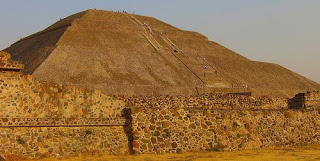http://www.flickr.com/photos/jungle_boy/151995494/
If you didn't take a tour, and you reach Teotihuacan by your own (Even if you're in a tour, some of them are just telling a lot of lies), this is an important guide for you. This site it's huge, marvelous in every detail and exciting if you know where to go.
Important Advices
As I told you, the site it's enormous and has a lot gates for enter to the city. The classic entrance to the city it's Gate 1 (Oh, what a surprise!), and is where the bus leave you and pick you up for your return. There are some advices that are important before you go to the city:
a) Bring water with you, plenty of it, 'cause it's gonna be hot, very hot!!. Buying it in the entrance it's not a good idea, the price it's too high in those stores, if you can, buy it in the city it's the best option.
b) You'll walk and climb a lot, and wearing sandals or something like that it's not the best idea. The pathways in Teotihuacan are covered with pebble, so, imagine that in your unprotected feet. Bring sneakers that's all.
c)Bring a hat, sombrero, cap or whatever you use to cover your head. Teotihuacan is sunny almost everyday, and the average temperature it's 80˚ F. Obviously, it's not recommended a great exposure to this conditions... please be careful.
Now, that I've told you some advices, let's enjoy the city
Historical Background
Teotihuacan was once the most important city in central Mexico (Altiplano Central), it was the cultural, economic and religious heart of all Mesoamerica. It was built by a combination of groups, and not from any of the most known groups of the region (Olmec, Totonoca, Mayan, Aztecs or Toltecs weren't the builders of the city).
There's evidence of human ocupation in the site from 800 b.C. (Teotihuacan mapping project), however the real important periods run from 150 to 550 A.D. where al the important buildings where built, and the city reach it's highest population, 125,000 inhabitans with 2,000 habitational complexes. It's influence can be trace from the northern cities (there were some cities there), to the Maya Region, in cities like Tikal and Kaminaljuyú (There's a part in Tikal that has the Teotihuacan architectonic style, it's believed that it was a district inhabited by Tehotihuacans).
It was an important center of obsidian production, In fact, it was because the obsidian produced in the city was unique, it can be traced in almost every important city in Mesoamerica. Some experts believe that this was the reason of it's importance in the region.
However, even it was the center of all mesoamerican activity, the city colapsed in only in 100 years (550 to 650 A.D.), it's not certain the real cause of this swift decline, there are a lot of beliefs and studies about the subject, but none of them are oficial or demonstrated.
The problem with all the knowledge of the site, is that there's no direct source, well, there are no source who can explain or tell us the history of Teotihuacan, there's only the things that the archaelogy has dugg from it's soil. We don't the language spoken in the city, neither the name of their gods or their kings, even the real name of the city and it's monuments it's a complete mistery (The name "Teotihuacan" was created by the aztecs 1,000 years later after the colapse of the metropoli), all we know it's what the bare rock tell us.
Well, after this historical brief, let's go to the site.... let's go!
Ver Teotihuacan en un mapa más grande





0 comments:
Post a Comment